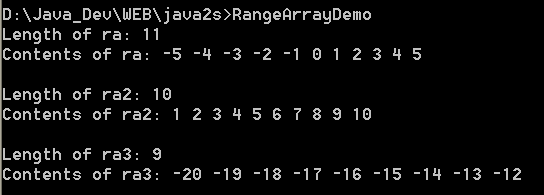Create a specifiable range array class

/*
C#: The Complete Reference
by Herbert Schildt
Publisher: Osborne/McGraw-Hill (March 8, 2002)
ISBN: 0072134852
*/
/* Create a specifiable range array class.
The RangeArray class allows indexing
to begin at some value other than zero.
When you create a RangeArray, you specify
the beginning and ending index. Negative
indexes are also allowed. For example,
you can create arrays that index from -5 to 5,
1 to 10, or 50 to 56.
*/
using System;
class RangeArray {
// private data
int[] a; // reference to underlying array
int lowerBound; // lowest index
int upperBound; // greatest index
// data for properties
int len; // underlying var for Length property
bool errflag; // underlying var for outcome
// Construct array given its size.
public RangeArray(int low, int high) {
high++;
if(high <= low) {
Console.WriteLine("Invalid Indices");
high = 1; // create a minimal array for safety
low = 0;
}
a = new int[high - low];
len = high - low;
lowerBound = low;
upperBound = --high;
}
// Read-only Length property.
public int Length {
get {
return len;
}
}
// Read-only Error property.
public bool Error {
get {
return errflag;
}
}
// This is the indexer for RangeArray.
public int this[int index] {
// This is the get accessor.
get {
if(ok(index)) {
errflag = false;
return a[index - lowerBound];
} else {
errflag = true;
return 0;
}
}
// This is the set accessor
set {
if(ok(index)) {
a[index - lowerBound] = value;
errflag = false;
}
else errflag = true;
}
}
// Return true if index is within bounds.
private bool ok(int index) {
if(index >= lowerBound & index <= upperBound) return true;
return false;
}
}
// Demonstrate the index-range array.
public class RangeArrayDemo {
public static void Main() {
RangeArray ra = new RangeArray(-5, 5);
RangeArray ra2 = new RangeArray(1, 10);
RangeArray ra3 = new RangeArray(-20, -12);
// Demonstrate ra
Console.WriteLine("Length of ra: " + ra.Length);
for(int i = -5; i <= 5; i++)
ra[i] = i;
Console.Write("Contents of ra: ");
for(int i = -5; i <= 5; i++)
Console.Write(ra[i] + " ");
Console.WriteLine("\n");
// Demonstrate ra2
Console.WriteLine("Length of ra2: " + ra2.Length);
for(int i = 1; i <= 10; i++)
ra2[i] = i;
Console.Write("Contents of ra2: ");
for(int i = 1; i <= 10; i++)
Console.Write(ra2[i] + " ");
Console.WriteLine("\n");
// Demonstrate ra3
Console.WriteLine("Length of ra3: " + ra3.Length);
for(int i = -20; i <= -12; i++)
ra3[i] = i;
Console.Write("Contents of ra3: ");
for(int i = -20; i <= -12; i++)
Console.Write(ra3[i] + " ");
Console.WriteLine("\n");
}
}
Related examples in the same category